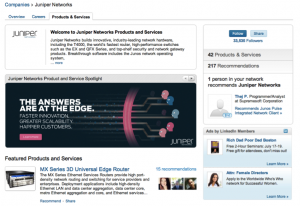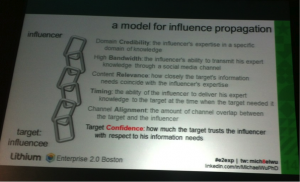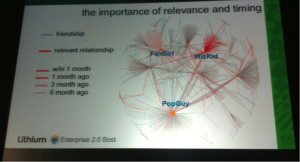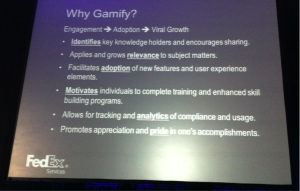Erik Qualman's Blog, page 661
June 27, 2012
Oreo Boycotted Over Gay Cookie on Facebook

Oreo, the hundred-year-old cookie brand, caused controversy Monday with an image of a rainbow-themed cookie.

This Rainbow Oreo image posted to Oreo's Facebook Page on Gay Pride Day sparked a heated controversy
The image, which is being universally interpreted as an endorsement of gay rights, has prompted a firestorm of emotionally charged tweets, blog comments and Facebook posts. Opponents of gay rights are now calling for a boycott of Oreos manufacturer Nabisco/Kraft Foods while supporters are petitioning them to actually produce and sell the cookie. Personally I’d love to see this cookie produced as it looks delicious. Also, as my fans and readers know, I’m a Christian family man (wife & two daughters) and supporter of Gay Rights. So I say bravo Oreo!

Oreo's Gay Pride Support and Oreo Rainbow image sparked hateful comments like those listed above on social media outlets
On Monday evening, Oreo posted to its Facebook page an image of an Oreo cookie stacked with six layers of colored creme filling, arranged to look like the iconic gay pride rainbow flag. The photo had the subtitle “June 25 Pride” and the caption, “Proudly support love!”
The image was posted on June 25, one day after the one-year anniversary of the legalization of same-sex marriage in New York.
As of this writing, the image has gathered over 165,000 “likes” and nearly 22,0000 comments on Facebook.
But while some commenters have declared their staunch support for Oreo — and even launched a Change.org petition urging Kraft to produce and sell the six-layer rainbow cookies — others have been more critical. Many commenters have denounced the company for supporting gay rights and for taking on political positions unrelated to its cookie-production mission.
Oreo does not have plans to produce the rainbow cookie depicted in the image, which was part of a campaign to celebrate the cookie’s centennial. The “current events” ad campaign has also included an ad parodying the pop song “Call Me Maybe.”
Kraft Foods representative Basil Maglaris told ABCNews.com that the ‘Pride’ ad is the first in a series of advertisements that will use images of Oreo cookies to observe current events and explained that the ad had been made “in recognition of Pride Month.”
“Kraft Foods has a proud history of celebrating diversity and inclusiveness,” the Oreo representative explained, calling the “Pride” ad “a fun reflection of our values.”
Oreo has been produced in a number of different variations over the years, from green tea to blueberry ice cream to the infamous triple double. If Kraft Foods ever does produce the 6-layer rainbow Oreo, it wouldn’t be the first major brand to market an explicitly pro-gay rights product in recent years.
The Vermont-based ice cream chain Ben & Jerry’s renamed its “Chubby Hubby” ice cream flavor “Hubby Hubby” in support of Vermont’s legalization of same-sex marriages in 2009, and the retail chain Target released a line of ‘Pride’ merchandise this June, according to ABCNews.com.
Hat tip >> Oreo’s Rainbow ‘Pride’ Cookie Prompts Internet Controversy
More:
Meet Gilbert Baker, the Man Who Invented the Gay Pride Rainbow Flag
Farewell, ‘Mr. Oreo’: Man Who Invented Creme Filling Dies at 76
[image error]
June 26, 2012
Infographic – 5 Killer Strategies to Dominate Social Media’s Big 3: Facebook, Twitter and YouTube

Our latest whitepaper, 5 Killer Strategies to Dominate Social Media’s Big 3: Facebook, Twitter and YouTube, serves as a best practice guide for marketers. We examine each platform and share five strategies marketers can apply to guarantee success for increasing brand awareness, fostering brand advocacy and generating leads and sales. Use this infographic as a quick-start guide for social marketing on the Big 3!
Marketers – let’s hear it!
How do you leverage the big 3 platforms to generate awareness and grow leads? Do you apply the 5 strategies above or do you rely on others? Share your favorite strategies with us on Twitter by tweeting to #AwarenessTips.
[image error]
June 25, 2012
Three areas to question in Facebook’s Business Model

A social network born out of a dorm room has come a long way over the past 8 years. Here are just a few stats to show its immense growth:
901 million monthly active users (March, 2012)
On average more than 300 million photos uploaded to Facebook per day (March, 2012)
An average of 3.2 billion Likes and Comments generated by Facebook users per day (March, 2012)
Despite its growth and ability to integrate in many aspects of our lives, Facebook has some areas us marketers question. Is it really a social network or an ad network? If it’s for marketers, then where are the advantages for marketers?
Facebook Ad Reach is Minimal
Although most brands have planted themselves on Facebook by adding Fan Pages, switching to Timeline, and perhaps even gone down the road of paid advertising, it isn’t always so simple to reach fans. Facebook doesn’t make it simple, nor do they give the reach once thought or expected. Most brands unless they truly engage with their consumers (shares, comments, likes, etc) will most likely reach 17% or less. In short, to get to fans not only must your brand have mouth watering, tantalizing content – but you need to fork up the big bucks and pay to reach your audience as well. The content is one thing, the money is another.
It has become more evident as even some brands have decided to put less effort into this ad network instead of putting all their ducks on board. “In mid-May, just ahead of Facebook’s IPO, GM’s marketing executives said they would pull $10 million in advertising from the social network after judging the efforts had “little impact” in reaching consumers.” Are they just the first of many?
Mobile: Who Will Dominate?
“Analysts also think Facebook will face difficulties deriving revenue from the growing n
number of Facebook users who access the site using mobile devices, through which Facebook derives much less advertising revenue than through a desktop PC. Facebook rivals Google and Apple currently dominate the mobile arena.” Although it’s key to have content mobile optimized, I know that I am even less likely to look or participate in ad content while I am on the go. As long as brands are not putting all their eggs in Facebook ads and Facebook content then the brands are marketing and strategizing correctly. There are so many other ways to get your content to where your audience wants it and where it wants it. Depending upon your brand platforms like Tumblr and YouTube may be better assets and drive more search traffic to that content. Mobile is great, but only if your content actually reaches your audience when they want it and where they want it.
Instagram Acquitision
Was this acquisition about being a “friend or foe?” Some wonder as now Facebook is looking into their own photo app for consumers – which looks quite similar to that of Instagram. I was initially impressed that Facebook had purchased such a great asset as Instagram – a photo app which so many upload to, view, and share on a consistent basis. Photos have such rich content that words cannot match at times – and Facebook realized the opportunity when they purchased the app. However, will they keep Instagram running and giving its audience what they want or will they use it as ammunition for their own photo app?
Facebook isn’t going anywhere anytime soon, but there are definitely pitfalls for marketers and consumers alike. Which platform will your brand turn to next? My 18 year old sister (the new generation) said it best…”Why would I spend time on Facebook, when there’s Twitter, Instagram and so many others…”
Additional Reading:
http://marketday.msnbc.msn.com/_news/2012/06/05/12069407-facebooks-problem-ads-arent-grabbing-users-analysts-say?lite
Image Credit:
http://www.laferle.com/tag/quitting-f...
http://softsupplier.com/tag/facebook/
[image error]
5 Killer Strategies for Brands to Engage on Pinterest and LinkedIn

Wondering if LinkedIn or Pinterest are right for your brand? You are not alone – marketers have been focusing their efforts on the Big 3 (Twitter, Facebook, and YouTube) but increasingly are looking to LinkedIn and Pinterest to build a presence and connect with their constituents. As a follow-on to our latest white paper, Five Killer Strategies to Dominate Social Media’s Big 3: Facebook, Twitter, and YouTube, which offers insights into how the leading social platforms can be used for marketing success, we turn to dissecting the best social marketing practices on Pinterest and LinkedIn, among the most popular social platforms of our days. LinkedIn boasts 147 million users and Pinterest recently hit 10 million unique active users. These two social networks hold untapped potential for reaching new customers waiting for your brand to make connections with them. Here are some ideas on how marketers can approach the social platforms along with some suggestions for tools they can use to get the most of their efforts. We also bring two great examples of brands doing it right on Pinterest and LinkedIn.
How to Use Pinterest and LinkedIn
While the social channels may seem different, marketers can successfully apply the same strategies to each by using different specific tactics. For example, successful use of Pinterest and LinkedIn requires great content, but on Pinterest it’s best to “avoid self-promotion” (see Pinterest’s terms and conditions), while LinkedIn content focuses heavily on company and product updates. Pinterest and Linkedin can be used by brands to effectively achieve key marketing goals such as:
Increase social reach
Engage fans through effective content
Identify and engage with influencers
Increase lead generation
Integrate activity with analytics
Pinterest How-tos:
Although Pinterest is still in its earlier stages, it’s clearly here to stay. Tools are popping up left and right to help marketers increase the effectiveness of their Pinterest efforts. Tools such as PinReach and PinPuff make identifying influencers easier and more efficient. Content development tools for Pinterest, such as Pinstamatic, Snapito, and Pinerly, allow brands to be creative and visually stimulating with their pins.
Chobani, a yogurt brand, uses Pinterest as a way to tap into their customers’ lifestyles and create a sense of brand loyalty. The themed boards are based on their target audience’s interests, such as recipes using yogurt, nutrition, and being active. Chobani uses creative titles, such as “Chobani Fit” and “Chobaniac Creations”, a clever strategy that have helped the brand gain over 6,000 followers on Pinterest.

Chobani used Pinterest to tap into their customers' lifestyles.
LinkedIn Success:
LinkedIn has gained a reputation for successful lead generation, with marketers ranking the platform as 277% more effective than other platforms in a marketing study conducted by HubSpot. The “Products and Services” tab that displays customer-generated recommendations make LinkedIn an extremely effective lead generation tool. Embedding the “Recommend on LinkedIn” widget on your homepage is one way to encourage customers to actively promote your brand.
Juniper Networks, a business-to-business company that offers high speed, reliable switching routers to satisfy ISP-level performance, has a great LinkedIn company page. With over 40 products and services listed, Juniper Networks has 215 customer recommendations on their “Products and Services” page. The “Overview” tab is effectively utilized with widgets that give the most important and updated information about the company.

Juniper Networks uses LinkedIn for promoting products and services and customer recommendations.
With the right strategies, LinkedIn and Pinterest can be powerful platforms to add to your social media toolbox. If you are looking to the make the most of your Pinterest and LinkedIn efforts, download our complimentary whitepaper, Beyond the Big 3: 5 Killer Strategies to Dominate LinkedIn and Pinterest. To learn more about how to boost your brand’s success on Pinterest and LinkedIn, download our recent white paper, Five Killer Strategies to Dominate Social Media’s Big 3: Facebook, Twitter, and YouTube.
Have you seen success from LinkedIn or Pinterest? We want to hear about it. Tell us your at #AwarenessTips.
Mike Lewis
@bostonmike
[image error]
Facebook: Active Ads Outperform Passive Ads
There are two types of ads on Facebook: Ones where there’s a passive action, or no action at all, and ones that communicate an activity – someone is doing something. Here we’ll discuss why the latter is often preferable.
Let’s start with the passive ads. Facebook still offers traditional external-website ads that come without social interaction whatsoever. You see an ad to the right of your feed – which only means you’re part of the advertiser’s target group – and if you click through you’re sent to the advertiser’s website.
Nothing you do is communicated to your friends and there are zero viral qualities.
On the opposite side of the spectrum we have sponsored stories which main purpose is to highlight an activity. If you use or share an application, check in somewhere, RSVP to an event, listen to a song, read an article etc., this information is spread to your friends (or more specifically, your friends that the Facebook algorithm thinks are relevant to this information.)
These ads show that you’ve made an effort to actually do something beyond clicking out to a webpage or just clicking “like”. You are using your valuable time to go to that concert, play that game, listen to that song, read that article or visit that restaurant.
Just go to yourself. Which one of these ads would you rather click?
1. Come Dine at Dani’s Bistro
2. [Name of your friend] Has Dined at Dani’s Bistro
Remember, you’re on Facebook to see what your friends are up to, and if the ads can communicate that, if they can tell a story, they often become much more effective.
Open Graph Opens for Active Ads
When Facebook started it was built around a social graph, a model that analyzes what everyone is doing on the site and shows that information to relevant friends.
Lately, Facebook has put a lot of effort into developing their open graph, which is the same thing but for external websites and apps. In other words, if you have an app you can connect this with Facebook’s API, and when someone uses the app you’re able to transfer this information to Facebook. The user’s friends will now see what he’s up to.
These ads focus solely on activity.
Data has shown that websites and app producers that connect with Facebook through the open graph raise their click-through rates with over 200%; action targeting also increase purchase rates with 150%.
Facebook users are simply driven by activity, and the action verbs connected to the open graph, such as watch, listen and play, are just much more effective than passive their passive counterparts. And if this action verb is connected to what your friends are up to, chances are that ad performance will improve.
If you use Facebook for business, think about how you can make your ads communicate activity rather than passiveness.
[image error]
Do YOU share to much online? Probably…

Have you ever thought you share too much on Facebook? Twitter? LinkedIn? The below infographic on online privacy shows you are not alone:

Courtesy of: www.online-education.net
[image error]
June 21, 2012
Day 3 of Enterprise 2.0: Race with the Machine #e2conf

Brought to you by @ScratchMM , the conference correspondent for Awareness, Inc. at E2
If there is a resounding message from E 2.0 that everyone needs to hear it’s this: we need to race with the machine, not against it. This was Andrew McAfee’s message as the first keynote speaker for the day – perhaps the most engaging, interesting and insightful speaker at the E2 conference this year. It would be easy to dedicate an entire book to Andrew’s teaching, but here, I’ll pull out a few highlights from his message:
The Big Data Conundrum
Everyone seems fascinated by the world of big data, as some would say, the world is one big data problem, with social software acting as a feeder for big data. As we witness a strange phenomenon – one where plots of sci-fi movies can become our true reality – we have to realize that we live in a new world that requires a different kind of thinking and an evolving set of skills:
Computers are growing smarter than humans, with remarkable speed . You needn’t go any further than the IBM Watson’s display at the conference to see the power of today’s computing. Computers have the power to do a lot of things better than people – autonomous-driving cars, proclaimed to be science fiction just a few years ago, are now a reality – and don’t just take Andrew McAfee’s word for it (who, by the way, drove one last year, and remarkably, is still around to share his insights):

Narrative Science, an innovative technology company that creates rich narrative content straight from data, has a guest column on Forbes that reports on companies’ earnings with remarkable precision without any human involved in the process. If you are beginning to wonder what would happen to the world of the journalist, then ask yourself this question – if computers are now as good as human scientists in predicting cancer triggers, what would the role of doctors and researchers be in the years to come? Computers are now better than humans at noticing different aspects of the cancer tissue predictive of cancer survival rates – and software today can find new triggers that scientists have never anticipated before. This machine-driven knowledge can help cure millions of people around the world, if only humans get on with it.
We have to admit it – we ain’t all that good after all. We are not good at algorithmic decisions, especially decisions that require input from an exponentially increasing number of sources. As humans, we are inherently limited by our own abilities and biases. Our belief that we are experts and that, with data, we can become better over time is being put to the test – consider the Second Half of the Chessboard. As Andrew explains, this is “where things become nutty, and exponential is so powerful that our brains lose the ability to deal with that reality.” This is where computers step in – they are better predictors of growth and pricing for everyday things like Bordeaux wine, better at predicting supreme court decision-making than 10 of the best experts in the world, better at predicting purchasing decisions, the list goes on. So what is a human to do in a world dominated by machine thinking? Race with the machine – let the machines answer the questions, and adapt by actively participating and evolving your skillset.
Collaborative IT
The other big theme of the day was Collaborative IT – as Nike’s Infrastructure Architect Art King put it, “empathy moves us forward.” IT has finally put itself in the shoes of their customers. IT thinking needs to change and the new imperative is adapting to the customer. The days of IT dictating and directing the customer are gone. Gone are the days of closed thinking, pushing software, controlling images, and dominating the conversations – 2012 and beyond is all about co-creating with the customer, where technology is intuitive and the training department is a thing of the past. Enterprise networking is adapting – CIOs and CTOs are now looking for legitimate ways to make iOS devices work behind the firewall, and make it work at work as smoothly as at home. It is about choice – so forward-looking companies are moving toward an app store mentality – where IT offers apps to their employees and customers and lets them choose the ones they want to use.
Management Hackathons
In the race to innovate, progressive companies are investing at all levels of their organizations to find new ideas, top management included. The Management 2.0 Hackathon, a joint collaborative project launched by the Management Innovation Exchange (MIX), Saba, and the Enterprise 2.0 Conference, launched in November of 2011, where management innovators from five continents came together to “participate in an intense, online, collaborative effort to explore how the principles and practical tools of the Web might make our organizations as adaptable, innovative, and inspiring as the Web itself.” 900 people came together, offering perspectives, generating ideas, leading teams, and contributing hacks. The guiding principles of the Management 2.0 Hackathon were those that foster all good business: 
Some fascinating hacks came out of the collaboration, including finding the ‘idea leaders’, the ‘natural leaders’ and the ‘hidden heroes’ within your organization with the help of social technology, hearing people’s voices via tweetstorms, and much more. To learn more about the hacks and this project, visit here. For more on the great line-up of speakers, visit E2 Boston.
Four Books Worth Reading:
Race Against the Machine by Andrew McAfee and Erik Brynjolfsson
The Collaborative Organization, by Jacob Morgan – it is a strategic guide to solving your internal business challenges using emerging social and collaboration tools
The Collaborative Imperative, by Ron Ricci and Carl Wiese. For those in marketing, I also highly recommend Momentum: How Companies Become Unstoppable Market Forces – one of the best books ever written on marketing by John Volkmann and Ron Ricci, ex VP of Positioning at Cisco.
Thanks, Lora, for sharing your thoughts and takeaways on Day 3 of E2.
What do you think? Are you with or against the machine? How is your organization adapting to the new social collaboration realities? Share your thoughts with us on this blog or on Twitter at @AwarenessInc.
[image error]
June 20, 2012
Enterprise 2.0 – Day 2 Conference Highlights

Brought to you by @ @ScratchMM , the conference correspondent for Awareness, Inc. .
It is great to be sharing the Hynes Convention Center in Boston with some of the top minds in social business collaboration at Enterprise 2.0 this year. As you can imagine, the conference is abuzz with community managers from around the world, and the speaker lineup is so remarkable, it is hard to choose which sessions to attend. That said, let me share what caught my attention yesterday:
Big themes:
1. Social collaboration is about business results:
The first keynote was delivered by Nathan Bricklin, SVP, Head of Social Strategy for Wells Fargo’s Wholesale Services. Nathan took an interesting approach to his session – he used a series of tweets from speakers he met at E2 last year to make his points. For Nathan, social collaboration is about specific results – as it is for Richard Foo, Collaboration Director at Nike. Besides sporting a nice Nike workout outfit, Richard stressed that for him and his team at Nike, which did not exist just two years ago, social collaboration is about connecting people within the Nike network that don’t know each other so ideas can flow more freely. As Richard put it, social collaboration is about the journey – there is no finish line. You have to keep it simple; start small and focus on the ‘why’ for the end users. Richard pointed out it is important for companies to stay the course. He notes that social collaboration is experiencing the same adoption cycle that we saw with email – initially people were suspicious about the benefits – who would really want to send an email when you can pick up the phone and talk? Now, email is part of our work DNA and, as everyone in the audience agreed, not going anywhere any time soon.
For a great in-depth review of the keynote sessions, read The Brainyard’s Enterprise 2.0 Keynoters: Time To Get In The Game by David Carr.
2. Social business is becoming increasingly data-driven
You may have sensed that – but to see the social experiment run by Michael Wu, Principal Scientist of Analytics at Lithium Technologies, was truly eye opening. Michael started his session by explaining how companies need to think about influence and its six core elements. Those elements, shown below, include Credibility, Bandwidth, Relevance, Timing, Alignment, and Confidence.

Michael Wu of Lithium Technologies shares how companies need to think about influence at Enterprise 2.0
It is about time we stopped being fooled by single measures of influence like Klout shows. There is a science behind how we can identify and plot influence – we just need to know what questions we want to address in the first place. As to the social experiment that Michael ran? Here’s what transpired at the end. An interesting note, R Wang is not physically present at E2 but he is right there, @rwang0 – yes, this is the power of social collaboration!)
To identify influence, Richard asked the audience to start tweeting using #e2exp as the hashtag. He showed how using Social Network Analysis companies can identify social influencers, their networks, and ways to engage them – internally or externally to an enterprise. When you know who the people are, how they are connected, and their level of expertise, you can then do some interesting data visualization as show below:

Social influence was a main topic of discussion Day 2 of Enterprise 2.0.
It is about time we stopped being fooled by single measures of influence like Klout shows. There is a science behind how we can identify and plot influence – we just need to know what questions we want to address in the first place. As to the social experiment that Michael ran? Here’s what transpired at the end. An interesting note, R Wang is not physically present at E2 but he is right there, @rwang0 – yes, this is the power of social collaboration!)
3. Mobile and Gamification
The talk by Bryan Barringer, Manager of Enterprise Collaboration Implementation at FedEx Services, was fascinating (although I have to admit that I am not really keen on the term gamification). His main point is that gamification, when applied correctly, can lead to wide internal adoption and viral growth.

Bryan Barringer of FedEx Services discussed the impact of gamification on internal adoption and viral growth.
Phillip Easter, Director of Mobile Apps at American Airlines, entertained by sharing a mobile vision for AA. He showed a video of their newest app in development – an app that let’s you communicate with customer service agents while on board without incurring additional costs. What can access to a live agent deliver? A delightful customer experience. You can imagine the reaction from the audience, including me – some people doubt that AA would staff their customer service adequately to be able to deliver a delightful experience but let’s not pick on our airline colleagues. After all, it is a tough business they are in.
Interesting E2 Afternoon Sessions:
- Marketo on Revenue Performance Management: Phil Fernandez, the President and CEO of Marketo, is a speaker who commands your attention. His passion and conviction are clear – to be a successful social enterprise, companies need to finally shed the old, traditional ways of thinking about the sales funnel. Enter Revenue Performance Management – or RPM, the new and much needed approach to aligning sales and marketing to support the buyer’s journey to a sale. There is no doubt we need RPM to make marketing work – according to Marketo’s own research, mature companies see 55%+ of their sales come from marketing leads, and the least mature – 15%. To make RPM a reality, Marketo doesn’t just sell software – they kick off every new client with a 2-day session where they help companies define what a lead is. That common definition then informs how marketing automation is done and ensures close alignment between sales and marketing. So the question is – are you practicing RPM or are you still stuck in the old sales funnel thinking?
- IDC on B2B social media: The big takeaway from the IDC session was that B2B buyers are still not influenced by social media. I disagree. B2B buyers may not be influenced by vendors’ social media, but B2B buyers are definitely using social means to make buying decisions. The IDC data was clear on that: B2B buyers say that social networks are influencing 18.6% of them, which, I have to agree, means that vendors are not successfully engaging the social buyers…yet. However, since 80% or more of B2B buyers are present in social networks, they visit business and tech blogs at least once a month (60%), and LinkedIn (45%), they have to be present to listen and learn. It is true – the new B2B buyers are experts, they don’t want to be sold to but want to be offered value – they want to be educated. So who is doing that successfully? Look no further than Marketo, which was not even on the map a few years ago.
Parting thought from Day Two: If you had to read just one point of voice on collaboration and social business, read Sameer Patel’s Will Social Meet Business blog post. Then ask yourself the question: are we still talking about just sharing, connecting, flows and streams or is there an innate understanding of what meaningful collaboration really entails?
Thanks, Lora, for offering your takeaways and thoughts on Day 2 of E2.
@BostonMike
[image error]
June 18, 2012
Facebook to Pay $10 Million to Charity in Settling Lawsuit

 The purse strings have been opened at Facebook again, as the social media giant has agreed to pay $10 million to charity to bring to a close a lawsuit that accused the site of violating users’ rights to control the use of their own names, photographs and likenesses. Considering the potential ramifications that Facebook could have been facing, $10 million is essentially a drop in the bucket.
The purse strings have been opened at Facebook again, as the social media giant has agreed to pay $10 million to charity to bring to a close a lawsuit that accused the site of violating users’ rights to control the use of their own names, photographs and likenesses. Considering the potential ramifications that Facebook could have been facing, $10 million is essentially a drop in the bucket.
The lawsuit, orchestrated by five Facebook members, alleged the social networking site violated California law by publicizing users’ “likes” of certain advertisers on its “Sponsored Stories” feature without paying them or providing them a way to opt out, according to court documents.
A “Sponsored Story” is an ad that shows up on a member’s Facebook page and typically consists of another friend’s name, profile picture and an assertion that the individual “likes” the advertiser.
The proposed class-action lawsuit, filed in federal court in San Jose, could have included close to one of every three Americans, with potentially $15 billion dollars in damages, according to prior court documents.
In the lawsuit, Facebook CEO Zuckerberg was quoted noting that a trusted referral was looked upon as the “Holy Grail” of advertising.
Also, the lawsuit referred to comments from Facebook COO Sheryl Sandberg, claiming that the value of a “Sponsored Story” advertisement was at least twice and up to three times the value of a standard Facebook.com ad minus a friend endorsement.
Facebook’s defense has focused on the argument that its users are thought to be celebrities among their network of friends, and, therefore, they are not protected by a number of privacy laws that protect non-celebrities. However, a recent piece in The Stanford Law Review indicated that treating ordinary individuals as “celebrities” within their social networks would have a negative impact when it comes to privacy rights:
According to U.S. District Judge Lucy Koh, the plaintiffs had demonstrated economic injury could occur via Facebook’s use of their names, photographs and likenesses. “California has long recognized a right to protect one’s name and likeness against appropriation by others for their advantage,” Koh wrote.
The settlement arrangement, known as a cy-pres settlement, means the settlement funds can be directed to charity.
Facebook has had its share of disappointments in the last month since its initial public offering (IPO) in May.
Going back to when Facebook was floated on the stock market exactly a month ago, Zuckerberg has watch nearly $5 billion from his personal fortune go by the wayside.
Don’t feel too sorry for him, however, as he is reportedly still worth a mere $14.5 billion.
As for those individuals looking to possibly cash in on a likewise lawsuit down the road, don’t exactly start counting the money just yet.
The case in U.S. District Court, Northern District of California is Angel Fraley et al., individually and on behalf of all others similarly situated vs. Facebook Inc., 11-cv-1726.
[image error]
June 15, 2012
Have a picnic June 17th to help a little girl in chemo

 Our mantra at Socialnomics is Social for Social Good. A mother (Holly Schopp) reached out to us, and you, our community, with a simple request to help her little daughter, Roxie. As a father of two young girls myself, this request touched my heart, and I hope it does the same for you. I’ve posted the letter from Holly and Roxie’s story below, and yes I will be having a picnic this Father’s Day and will be wearing my Team Roxie t-shirt and sharing it socially. I hope you enjoy a picnic with your loved ones and share your support of the Roxie’s of the world.
Our mantra at Socialnomics is Social for Social Good. A mother (Holly Schopp) reached out to us, and you, our community, with a simple request to help her little daughter, Roxie. As a father of two young girls myself, this request touched my heart, and I hope it does the same for you. I’ve posted the letter from Holly and Roxie’s story below, and yes I will be having a picnic this Father’s Day and will be wearing my Team Roxie t-shirt and sharing it socially. I hope you enjoy a picnic with your loved ones and share your support of the Roxie’s of the world.
Dear Erik:
Our daughter Roxie was a healthy and happy child, then in a routine check-up she was diagnosed with Neuroblastoma, the most common cancer in infancy. Close to 50 percent of neuroblastoma cases occur in children younger than two years old. Between 20% and 50% of high-risk cases do not respond adequately to induction high-dose chemotherapy. Our little Roxie is currently undergoing Chemo (Day 5 post below).

Roxie is currnelty going through chemotherapy in her battle against Neuroblstoma
Our hopes are high that she is one of the survivors. Roxie may be small, but she is a fighter. Our community has rallied around Roxie and have been wearing Team Roxie T-Shirts in support of our little girl and the fight against Neuroblastoma.
So here’s my big favor- are you ready for it- you may not be up for the challenge, Ok here it goes…
I am asking you to have a picnic with your family. Nothing big, nothing fancy, we’re talking sheet on the ground in your own back yard – or do it up high style at a park with a pavilion, whatever works for you. June 11-17 is International Neuroblastoma Awareness Week and on the schedule for June 17th is a global invitation to sit down with your family for a picnic.
Well, we can’t. So please, in an effort to help bring awareness to neuroblastoma, have one with your family for me. Take a picture, throw it up on Facebook & Twitter and in the caption write my mantra- KNOW Neuroblastoma/NO Neuroblastoma. Maybe if you have time, do a little research and include a high risk neuroblastoma fact under “KNOW Neuroblastoma/NO Neuroblastoma”. Then share it. If even one person in your network does a little searching after seeing your picture because they’re not sure why you’re talking about neuroblastoma or what it even is, they will learn of it and understand why it needs to be gone. It will start a conversation and we’ll have accomplished something huge together.
My family and families like mine need your help getting the word out.
Say it with me! “KNOW Neuroblastoma/NO Neuroblastoma”

The Community Rallies Around Team Roxie's Infectious Spirit with Team Roxie T-Shirts
Chemo Treatment:
Roxie was kind of happy to be back at the hospital. She loves all of her cards on the wall. I am so happy I took the time to do that. It was therapeutic for me and I didn’t even think about how I would be positively affected by rereading the cards as I was hanging them. It truly put me in the right frame of mind and reminded me that there are so many people who’s lives are being touched by Roxie. I had also underestimed how many cards we had. Rema (Roxie’s nurse-who btw is wearing her Team Roxie tshirt today) and Jess (one of Roxie’s favorite techs-who btw was wearing her Team Roxie shirt yesterday) both helped me hang some of the well wishes. We had only made it through about a 1/4 of the box when the wall was already covered. You all have sent us so much love. Where I had been intimidated once before, after I had posted the cards, I left to head back home to grab Roxie felling like, “we got this.”
techs-who btw was wearing her Team Roxie shirt yesterday) both helped me hang some of the well wishes. We had only made it through about a 1/4 of the box when the wall was already covered. You all have sent us so much love. Where I had been intimidated once before, after I had posted the cards, I left to head back home to grab Roxie felling like, “we got this.”
2nd day of chemo and this is the first time I’ve sat down. The dr tells me Roxie could be feeling poorly in the next day or two, so until then-we’ve got her up and moving!
We started this morning with playing drums in music therapy(Roxie told Ms Christy all about Dinosaur Train and Ms Christy told Roxie about the song “everybody walk the dinosaur” and now Rox is obsessed with listening to it on the ipad-boom, boom, akka lakka lakka boom), then child life came and played Plato, then we had bath/water play time, a dressing change, a visit from Ms Kim (our home healthcare nurse), then occupational therapy came and worked with scissors and a big puzzle, then lunch and now we’re with the physical therapist whose using all kinds of clever tricks to get her to stretch and exercise.
We’ve got a calendar up for hospital staff and friends to start filling in times for future visits. Roxie is still eating well and in a fabulous mood. Today is a very good day!
Love, Holly
Captain of Team Roxie
http://teamroxie.weebly.com/
I have had many people ask if they could send a card to Roxie while we’re admitted and the answer is, Yes! She really does love receiving mail. Our address here is:
Roxie Schopp
St. Louis Children’s Hospital
1 Children’s Place
9th Floor, BMT 5
Saint Louis, MO 63110
>>Donate
[image error]




